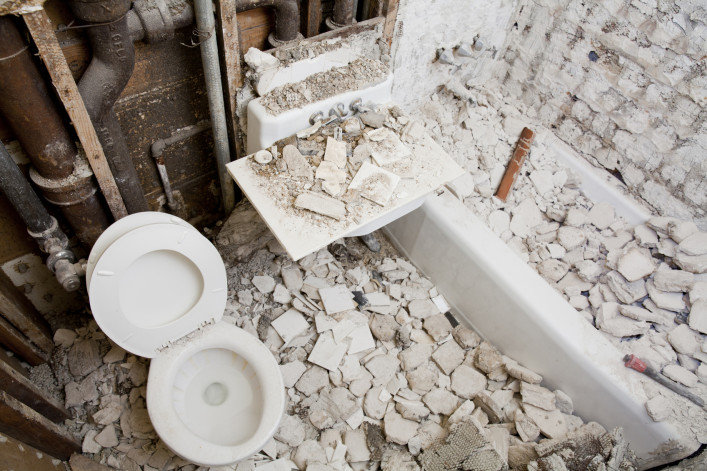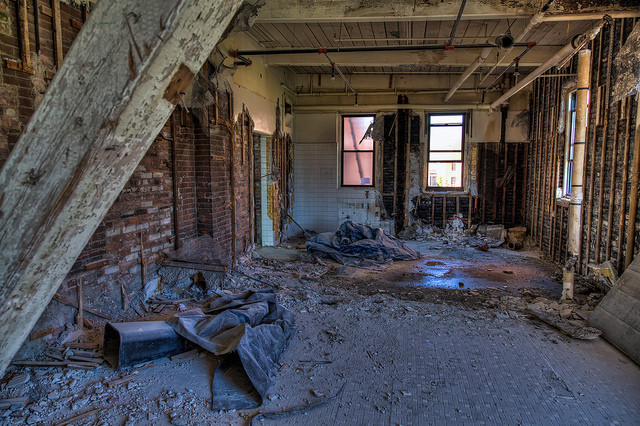Can't upgrade all at once? How to plan a piece-by-piece renovation

Even if you've just purchased a fixer-upper with the intent to overhaul, for reasons both logistical and financial, not every owner has the bandwidth to take on a full-scale gut renovation all at once. But overhauling a home is a tricky business, and if you're hoping to improve your abode a little bit at a time, you'll need to plan just as carefully as you would for a huge, rip-the-Band-aid gut job.
Below, key factors to keep in mind when planning out a piecemeal makeover:
Prepare to pay more in the long run
Multiple experts warn that in the long run, upgrading your home bit by bit can end up being more expensive than doing the whole project in one fell swoop, since you keep having to hire and re-hire your team, rather than paying them a lump sum for a larger job. (Think of it like buying their time in bulk.)
"Some people do renovations piece by piece because they can't afford to do the whole thing at once, but it actually ends up being more costly," says Jeff Streich of Prime Renovations. "Every person will charge more money every time they have to come back. So say your demolition guy might charge $5,000 for the whole house, but it'll still be $3,000 if you bring them in for just the bathroom."
On top of that, if you're wrangling people yourself rather than working with a contractor throughout the project, there's a higher likelihood of running into problems. "Hiring a general contractor is hiring someone whose core skills are sourcing, scheduling, management, and the coordination of skilled professionals to make sure they're all doing the right thing at the right time," adds Fraser Patterson, founder of Bolster (FYI, a Brick sponsor). "And when you get that part wrong, it starts to cause problems."
This doesn't mean that it doesn't make financial sense for you to space things out if you don't have a huge lump sum of cash on hand, but it's wise to go into the planning process with your eyes wide open about the long-term costs.
Know when to bring in a professional
As much as we romanticize the DIY home makeover these days, it's important to know your limits—and what jobs will require the assistance of a pro.
"Anything structural, mechanical, or the moving of systems [such as plumbing], it's like operating on your own heart. It's hugely unadvisable," warns Patterson. "It usually turns into a nightmare for people, and at that point the 'D' in DIY stands for 'destroy'."
If you're an amateur carpenter or love to paint, that's one thing, but for work on more complicated jobs such as your home's foundation, wiring, and plumbing, there's smaller room for massive errors. "You don't want your home to become a testament to your learning process," notes Patterson.
Prioritize the big stuff first
When planning your actual schedule for renovation, you'll want to focus on large (and expensive) structural tasks first, and save the cosmetic work for later. This is a mixture of practicality—you want everything to be safe and functioning before you make it beautiful—and necessity, since the more intensive tasks are best gotten out of the way before you settle in.
To help determine your schedule, Doug Bowen, a Douglas Elliman broker who has renovated numerous townhouses, recommends finding a trustworthy contractor, and working together to create a priority list.
"Things that are in the walls that need to get updated, like electrical and plumbing, those are things you need to do all at once, and do first," says Drew Nichols, who has chronicled his own DIY renovation with his wife on the blog Brownstone Cyclone. "If you want to open up walls, you don't want to do that when your house is finished," he says, as it's a process that creates a lot of disruption and debris. (More on that below.)
For townhouses, Bowen recommends focusing on any necessary roof repairs first (as leaks can trickle down and damage the rest of the property), as well as potential issues with the foundation, water main, and bearing beams in the basement. "It’s the unsexy stuff that’s the most important stuff to fix," Bowen explains. "And that will affect your quality of life. If you move into a fixer-upper townhouse, you want to address those issues first."
And whether you're in a townhome or an apartment, on top of the electrical and plumbing, you'll want to strategize to take care of messy, dusty work before you move in. "Anything to do with your chimney or fireplace is super messy, and you'll want to get out of the way earlier," says Nichols. "And any demolition, framing for new walls, electrical and plumbing, try to do those things before you move in, because it's really hard to live in a home while you're doing them."
Similarly, Streich recommends skim-coating walls prior to move in, as the work creates a lot of dust. "And if you want wall sconces, that's a dusty thing, as well," he adds. "The biggest problem with people living in an apartment while renovations are happening is dust and debris."
On the flip side, says Streich, you can potentially put off your kitchen and bathroom overhauls (providing you're not moving any major plumbing lines), as those upgrades are relatively easy to live with—that is, if you have backups. "As long as you have two bathrooms you can do the bathroom whenver you want," says Streich. "And kitchens you can do anytime, as long as it's a big enough apartment. You can temporarily move the fridge and microwave. We've done many kitchens where people still lived in the apartment."
Treat your materials carefully
Particularly for the budget-minded renovator, it can be tempting to bargain-hunt for fixtures, flooring, and appliances, then save them for when you're ready to start that phase of your renovation. But if you go this route, proceed with caution.
"Flooring, for instance, needs to be stored at a certain humidity level, and I once saw a project where the homeowner stored theirs in the garage, then found out it had warped," says Patterson. "I've also seen really beautiful toilet fixtures, counters, cabinetry in boxes being moved around while work is going on, and that's a recipe for disaster."
It doesn't mean you can't scoop up desirable pieces a bit at a time, but Patterson advises, "If you do buy things ahead of time, get smart about how you store them. You might even be able to have the manufacturer store it for you, but if not, read the instructions and learn how to store your materials correctly."
Save the floors until the very end
As you paint, scrub, sand, and shuffle things around, the floors of your home will naturally bear the brunt of the work. So if if you're planning to finish or replace them, save that step for last.
"Masonry, dust, little pieces of sandy get everywhere," says Nichols. "All that has to happen is someone steps on something once, and it grinds into the floor."
For this reason, Patterson adds. "I've seen lots of nice flooring with paint all over it. Usually you leave that to the end—it's just common sense. You don't want to lay down flooring then do construction work all over it."
You Might Also Like

























